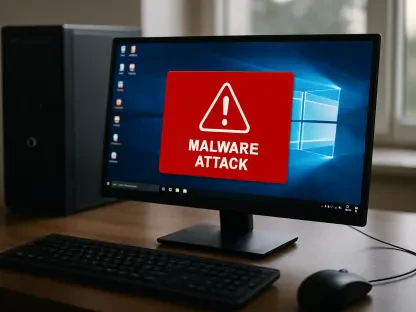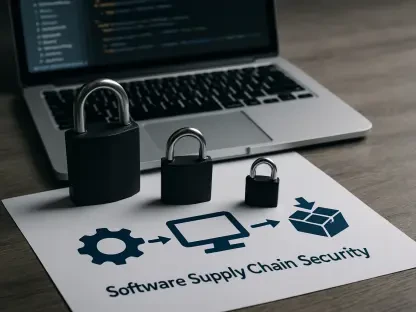What happens when the very infrastructure meant to protect and scale an organization’s data becomes the perfect tool for devastating theft? In today’s digital landscape, hybrid cloud environments—blending on-premises and cloud systems—offer unmatched flexibility, but they also present a chilling vulnerability that cybercriminals can exploit. A financially motivated threat actor, known as Storm-0501, has mastered the art of exploiting these setups, turning them into conduits for data exfiltration and destruction. This feature dives into the shadowy tactics of this group, uncovering how they navigate complex systems to wreak havoc on businesses across multiple sectors.
The Rising Danger of Hybrid Cloud Exploits
The shift toward hybrid cloud solutions has transformed how organizations operate, offering seamless integration of on-premises servers with cloud platforms. However, this evolution has also opened a Pandora’s box of security risks. Storm-0501 capitalizes on misconfigured systems, unpatched vulnerabilities, and unmanaged devices, making hybrid environments a prime target. With data breaches costing companies millions annually—often hitting critical sectors like healthcare and government—the stakes couldn’t be higher. Understanding the methods of such threat actors is no longer just a technical issue; it’s a vital business priority in an age where digital infrastructure underpins nearly every operation.
The significance of this threat lies in its scale and sophistication. Unlike traditional cyberattacks focused on locking files for ransom, modern groups like Storm-0501 prioritize stealing vast amounts of data and obliterating backups, leaving victims with little chance of recovery. Their ability to exploit the interconnected nature of hybrid systems means that no organization, regardless of size or industry, is immune. This story matters because it highlights a fundamental shift in cybercrime, demanding immediate attention to safeguard critical information in an increasingly cloud-dependent world.
Inside the Mind of a Cyber Predator
Storm-0501 operates with surgical precision, leveraging a multi-stage attack chain to infiltrate and devastate hybrid cloud environments. Their process often begins with gaining initial access through stolen credentials or by targeting vulnerabilities in internet-facing servers such as Zoho ManageEngine or Citrix NetScaler. Collaborating with access brokers, they secure a foothold in the system, setting the stage for deeper penetration. Once inside, the group escalates privileges using techniques like DCSync attacks, mimicking domain controllers to extract credentials and gain domain admin control.
From there, the attackers move laterally, bridging the gap between on-premises networks and cloud resources like Microsoft Entra ID and Azure. They exploit Directory Synchronization Accounts and non-human identities lacking multi-factor authentication to access critical systems. A striking example unfolded in a recent campaign against a large enterprise with multiple subsidiaries, where the group registered malicious federated domains for persistent access, exfiltrated sensitive data, and deleted Azure resources to cripple recovery efforts. Their final move—demanding ransom through compromised Microsoft Teams accounts—adds a layer of psychological pressure to an already catastrophic breach.
Adapting to an Evolving Menace
Experts have noted a disturbing evolution in the tactics of Storm-0501, describing their approach as a paradigm shift in ransomware strategies. A spokesperson from a leading threat intelligence team remarked, “These attackers exploit cloud-native capabilities to maximize damage, moving beyond encryption to data theft and destruction.” Active since at least 2025, the group has transformed into a ransomware-as-a-service affiliate, deploying payloads like BlackCat and LockBit across a range of targets. Their adaptability is evident in campaigns affecting diverse entities, from educational institutions to law enforcement agencies, showcasing an opportunistic approach that spares no sector.
The real-world impact of these attacks paints a grim picture. Schools have lost critical student data, while government bodies have faced disruptions in essential services, all due to the group’s ability to navigate hybrid setups with ease. This trend underscores a harsh reality: conventional security measures fall short in protecting against threats that exploit the unique complexities of cloud integration. The urgency to rethink defense mechanisms has never been clearer, as the scope of potential victims continues to expand with every passing day.
The Human Cost of Digital Warfare
Behind the technical intricacies of Storm-0501’s operations lies a profound human toll. Imagine a hospital unable to access patient records during a crisis because attackers have wiped critical cloud backups, or a small business forced to shut down after losing years of proprietary data to extortion demands. These scenarios are not hypothetical—they are the lived experiences of organizations targeted by this relentless threat actor. The emotional and financial strain on employees, executives, and customers alike reveals the true cost of failing to secure hybrid environments.
Beyond immediate losses, the ripple effects of such breaches erode trust in digital systems. Clients hesitate to share sensitive information, while employees grapple with the fallout of disrupted operations. A cybersecurity analyst shared a sobering perspective: “When data is stolen and destroyed, it’s not just a technical failure—it’s a betrayal of trust that can take years to rebuild.” This human dimension emphasizes that countering these threats is not solely about technology; it’s about protecting the very foundation of modern organizational integrity.
Building a Fortress Against Cloud Threats
Countering the sophisticated exploits of Storm-0501 demands a robust, multi-layered defense strategy tailored to hybrid cloud environments. Organizations must start by securing initial access points through regular patching of internet-facing servers and enforcing stringent password policies. Implementing multi-factor authentication across all identities, especially for non-human synced accounts, is critical to blocking privilege escalation. Additionally, limiting domain admin access and securing Directory Synchronization Accounts can prevent attackers from gaining sweeping control over networks.
Network segmentation offers another vital safeguard, restricting lateral movement between on-premises and cloud systems. Real-time monitoring for suspicious activities, such as unauthorized tenant registrations, can help detect intrusions early. Equally important is preparing for the worst—maintaining secure, offline backups and testing disaster recovery plans ensures resilience against data deletion attacks. By adopting these actionable measures, businesses can transform potential weaknesses into fortified barriers, significantly reducing the risk posed by relentless threat actors.
Reflecting on a Battle Fought
Looking back, the saga of Storm-0501 served as a stark reminder of the vulnerabilities embedded in hybrid cloud systems. Their cunning exploitation of interconnected environments exposed gaps that many organizations had overlooked, leaving a trail of financial and emotional devastation. Each attack, from data theft to resource deletion, highlighted the evolving nature of cyber threats and the urgent need for vigilance.
Moving forward, the lessons learned pointed toward a clear path: strengthening security with proactive measures like multi-factor authentication and regular system updates became non-negotiable. Businesses began to prioritize comprehensive training for staff, ensuring awareness of phishing attempts and credential theft risks. The fight against such adversaries also sparked greater collaboration within the cybersecurity community, fostering shared intelligence to anticipate and mitigate future threats. Ultimately, the experience underscored that safeguarding digital assets required not just technology, but a cultural shift toward relentless preparedness.









